6 Proven Team Effectiveness Models to Maximize Performance
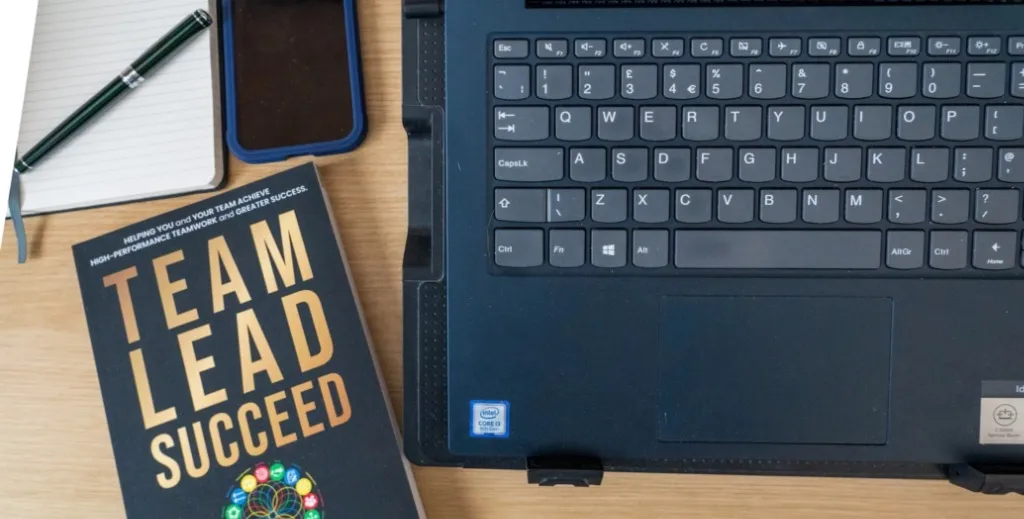
In any organization, teamwork is essential. A team can be effective if its members communicate well with one another and get things done efficiently. A successful team is more than just a group of talented individuals; it’s also one that has been carefully assembled, follows structured processes to ensure high-quality work, and uses appropriate technologies.
To help your team operate more effectively, you can use a model for assessing team effectiveness. This will enable the group to identify ways to improve and provide performance-enhancing strategies.
6 Team Effectiveness Models
These six different models for understanding and improving team effectiveness.
1. GRPI model
The first team effectiveness model we will discuss is the GRPI model developed by Rubin, Plovnick, and Fry. GRPI, an acronym for Goals, Roles, Processes, and Interpersonal Relationships, is a tool that helps teams assess their effectiveness.
Goals:
A team’s goals must be clear, specific, and measurable. The team members must have a shared understanding of the goals and a commitment to achieving them.
Roles:
Each team member must clearly understand their role in achieving the team’s goals. The team leader must assign roles based on each member’s strengths and skills.
Processes:
The team must have clear procedures in place for decision-making, problem-solving, and communication. Effective sales team communication, for instance, is crucial in ensuring that everyone on the team is on the same page and working towards the same goals.
Interpersonal Relationships:
A team’s success depends on the relationships between team members. Each member must respect and trust their teammates, communicate openly and honestly, and be willing to offer support and assistance.
2. Katzenbach & Smith Model
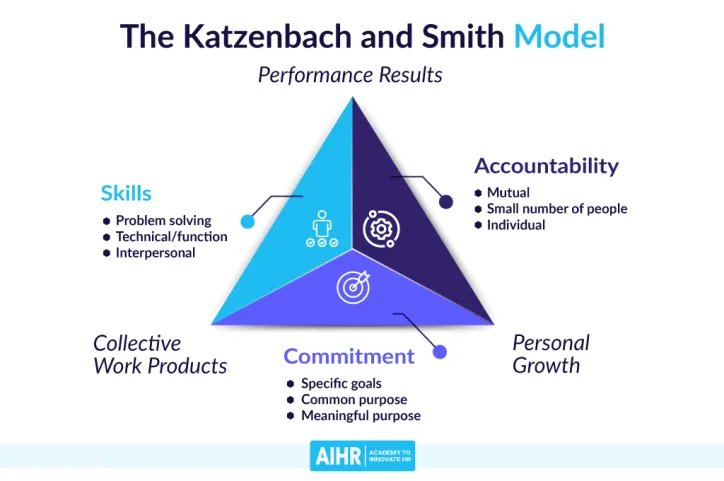 Image Credit: aihr.com
Image Credit: aihr.com
The Katzenbach and Smith Model is another team effectiveness model that stresses the importance of a clear team identity and shared goals. According to this approach, effective teams have three critical components: Team Definition (a clearly defined purpose or task), Performance Goals (objectives toward which the group should strive), and Interpersonal Relationships between members.
Team Definition:
A team must clearly understand its purpose, scope of authority, and the boundaries within which it operates. This clarity helps to ensure that team members are aligned with their goals and objectives.
Performance Goals:
Effective teams must have clear performance goals aligned with their purpose. These goals must be measurable and challenging to motivate team members.
Interpersonal Relationships:
Effective teams must have strong interpersonal relationships built on trust, respect, and open communication. When team members trust each other, they are more likely to work together toward achieving the team’s goals.
3. T7 Model
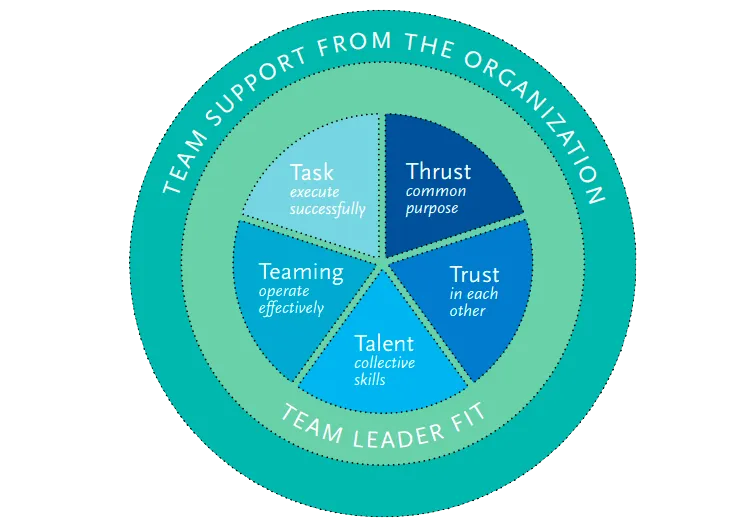 Image Credit: riter.co
Image Credit: riter.co
The T7 Model of Team Effectiveness is a holistic approach to team effectiveness. In this model, seven critical components are essential to the success of any team: teamwork (primarily trust), taskwork, talents/resources, training & development tactics, and time management.
Teamwork:
Effective teams must work together to achieve their goals. They must collaborate, communicate, and support each other to achieve their objectives.
Task work:
Teams must have clear objectives and know the tasks they must complete to achieve their goals. Each team member must understand their role in completing the tasks.
Trust:
Teams must have trust in each other’s abilities, intentions, and commitments. Without trust, teams will struggle to work together effectively.
Talent:
Teams must have the right people in the right roles to achieve their goals. Each team member must have the skills and knowledge necessary to contribute to the team’s success.
Training:
Teams must be trained in the skills necessary to achieve their goals. Ongoing training helps to ensure that team members are equipped with the latest knowledge and skills.
Tactics:
Effective teams must have tactics in place to achieve their objectives. These tactics may include project planning, communication strategies, and risk management plans.
Time:
Teams must have enough time to complete their tasks and achieve their objectives.
4. LaFasto and Larson Model
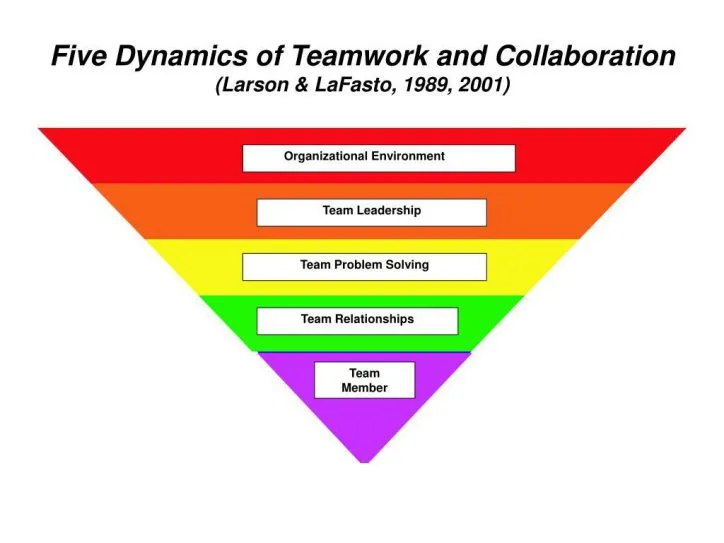 Image Credit: riter.co
Image Credit: riter.co The LaFasto and Larson Model (Five Dynamics of Teamwork and Collaboration) is another team effectiveness model that emphasizes the importance of a supportive team environment and clear expectations. The eight critical components of the model are: Environment, Resources, Support, Clarify, Objectives, Commitment, Standards, Evaluation.
Environment:
Teams must have a supportive environment that encourages open communication and collaboration.
Resources:
Teams must have the resources they need to complete their tasks effectively. This includes adequate funding, equipment, and personnel.
Support:
Teams must have support from management and other stakeholders to be successful.
Clarify:
Teams must have clear expectations and roles that are communicated effectively to all team members.
Objectives:
Teams must have clear objectives aligned with the organization’s goals.
Commitment:
Team members must be committed to the team’s objectives and goals.
Standards:
Teams must have clear standards and expectations for performance and behavior.
Evaluation:
Teams must regularly evaluate their performance and make adjustments as necessary.
5. Hackman Model
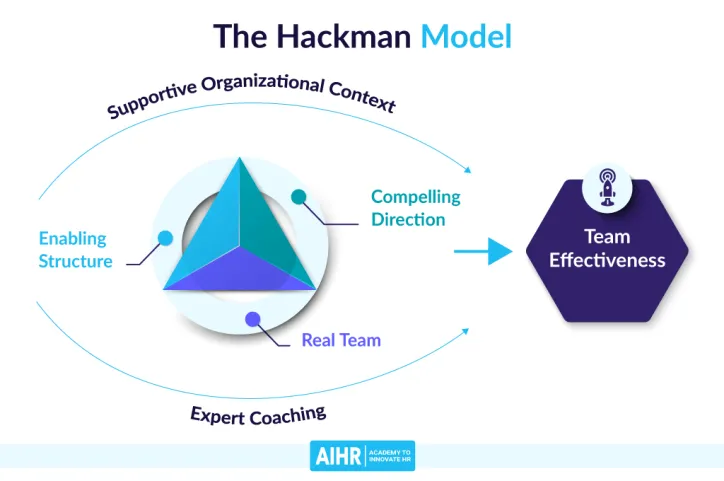 Image Credit: aihr.com
Image Credit: aihr.com
The Hackman Model of Team Effectiveness emphasizes the importance of designing teams with clear goals and roles. This model has four critical components: Task Demands, Team Composition, Norms (or group culture), and a set way that members communicate with each other in meetings.
Task Demands:
Teams must have clear goals and objectives that are challenging but achievable.
Team Composition:
Teams must be composed of individuals with the necessary skills and expertise to achieve their goals.
Norms:
Teams must have clear norms and expectations for behavior and performance.
Team Processes:
Teams must have effective processes for decision-making, communication, and conflict resolution.
6. Lencioni Model
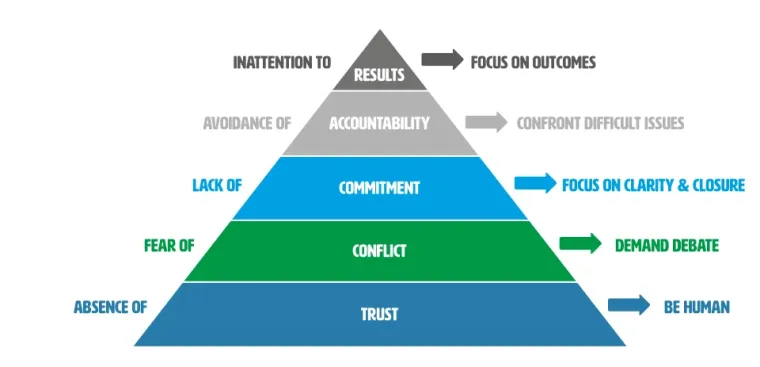 Image Credit: mtdtraining.com
Image Credit: mtdtraining.com
Based on the belief that trust and accountability are essential for team success, the Lencioni Model emphasizes building a foundation of those two core values. The five critical components of this model are: Trust and Accountability; Conflict Resolution; Commitment to Teamwork; Measurement / Rewards & Recognition.
Trust:
Teams must have trust in each other’s abilities and intentions to work together effectively.
Conflict:
Teams must be able to manage conflict constructively to avoid destructive conflicts that can harm team performance.
Commitment:
Team members must be committed to the team’s objectives and goals.
Accountability:
Teams must hold each other accountable for their performance and behavior.
Results:
Teams must focus on achieving results aligned with their goals.
Wrap-Up on Team Effectiveness Models
Team effectiveness is an essential component of any successful organization. The models discussed in this blog offer different perspectives on what makes teams effective, and each model can be useful in different situations. Effective teamwork helps you identify areas for improvement, develop strategies to enhance team performance, achieve your goals, and have more effective meetings.
However, it’s important to note that implementing a team effectiveness model is not a one-time fix. It is essential that you work with your team to continually monitor and evaluate its performance so that you can make the necessary changes. Remember, a team is only as strong as its weakest link, and by working together, you can create a team that is greater than the sum of its parts.




